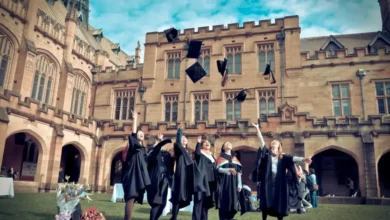Work and Study in USA 2025/2026: Complete Application Guide
The United States is one of the most popular countries in the world for international students. Every year, thousands of students apply to study in American universities and many also look for part-time jobs to support themselves. If you are planning to apply for study and work opportunities in the USA for 2025/2026, this guide will give you everything you need to know — from admissions to visas, jobs, and practical tips.
Why Choose the USA for Study and Work?
-
Top-ranked universities – The USA is home to world-famous institutions such as Harvard, MIT, Stanford, and hundreds of strong public and private universities.
-
Diverse programs – You can study almost any subject, from engineering and business to arts, health sciences, and technology.
-
Part-time job opportunities – Many students work on or off campus while studying.
-
Career growth – Graduates can apply for Optional Practical Training (OPT) or H-1B work visas to build a career in the U.S.
-
Cultural experience – Living in the USA exposes you to different cultures, ideas, and international networks.
How to Apply for Study in the USA (2025/2026)
Applying to study in the U.S. takes preparation. Here are the main steps:
1. Choose a University and Program
-
Research universities that match your academic goals.
-
Use official platforms like EducationUSA or university websites.
-
Check if your program starts in Fall (August/September) or Spring (January).
2. Meet the Admission Requirements
Each university sets its own rules, but most require:
-
Academic transcripts from high school or previous university.
-
English language test (TOEFL, IELTS, or Duolingo English Test).
-
Standardized test scores (SAT/ACT for undergraduates, GRE/GMAT for some graduate programs — though many schools are now test-optional).
-
Statement of Purpose or Motivation Letter.
-
Letters of Recommendation.
3. Submit Your Application
Applications are usually done online via the university portal or common systems like the Common App. Always check deadlines carefully:
-
Fall intake (main semester): Applications open about one year before, and deadlines are usually between November and January.
-
Spring intake: Deadlines often fall between July and September.
4. Receive Admission Decision
If you are accepted, the university will send you an I-20 form, which you will need for your visa application.
5. Apply for Scholarships and Financial Aid
The USA offers scholarships for international students through:
-
Universities (merit-based or need-based aid).
-
Government programs like Fulbright.
-
Private foundations.
Visa Application for USA Study
To study in the USA, you need a student visa:
-
F-1 Visa – The most common visa for academic studies.
-
M-1 Visa – For vocational or technical programs.
-
J-1 Visa – For exchange students.
F-1 Visa Application Process
-
Get your I-20 form from the university.
-
Pay the SEVIS I-901 fee.
-
Complete the DS-160 visa application form online.
-
Schedule a visa interview at the U.S. embassy or consulate in your country.
-
Attend the interview and provide documents (passport, I-20, admission letter, proof of funds, visa fee receipt).
Working While Studying in the USA
International students on F-1 visas are allowed to work under certain conditions:
1. On-Campus Employment
-
You can work up to 20 hours per week during classes and full-time during breaks.
-
Jobs include library assistant, cafeteria worker, or research assistant.
2. Curricular Practical Training (CPT)
-
CPT allows students to work in internships related to their field of study.
-
You must get permission from your university and the job must be part of your program.
3. Optional Practical Training (OPT)
-
OPT allows you to work for 12 months after graduation in your field of study.
-
STEM graduates (Science, Technology, Engineering, Math) can apply for a 24-month extension, giving them up to 36 months of work authorization.
After Graduation: Work Opportunities
If you want to stay and work in the U.S. after studies, you have options:
-
H-1B Visa (Work Visa) – Many graduates move from OPT to an H-1B visa if they find an employer willing to sponsor them.
-
Green Card Pathways – Some students later apply for permanent residency through employment, family, or other categories.
-
Further Studies – Many continue into graduate or PhD programs, which can also extend their stay.
Cost of Studying and Living in the USA
Studying in the USA can be expensive, so financial planning is important.
-
Tuition fees: $20,000 – $55,000 per year depending on the university and program.
-
Living costs: $10,000 – $18,000 per year (housing, food, transport, insurance).
-
Health insurance: Often required, costing around $1,500 – $3,000 per year.
Part-time jobs and scholarships can help reduce expenses.
Tips for a Successful USA Application (2025/2026)
-
Start early – Begin researching and preparing documents at least one year in advance.
-
Take English tests early – Don’t wait until the last minute to take TOEFL, IELTS, or other required exams.
-
Apply broadly – Apply to more than one university to increase your chances.
-
Show strong finances – Proof of funds is required for both admission and visa approval.
-
Stay organized – Keep track of deadlines, forms, and documents.
-
Practice for the visa interview – Be confident, honest, and prepared to explain your study plans.
Job Hunting Tips for Students and Graduates
Finding work in the U.S. is competitive but possible with preparation:
-
Use career centers at your university.
-
Apply for internships early (CPT and OPT opportunities).
-
Build a LinkedIn profile to connect with recruiters.
-
Attend career fairs on campus and in your city.
-
Learn American-style resumes and cover letters (short, clear, and focused on skills).
Frequently Asked Questions (FAQ)
1. Can international students work off-campus in the USA?
Yes, but only through CPT or OPT programs with university approval.
2. Is the USA expensive for students?
Yes, but scholarships and part-time jobs can help. Tuition varies by university.
3. How long can I stay after graduation?
You can stay up to 12 months on OPT, and STEM students may stay for 36 months if approved.
4. Do I need to know English before applying?
Yes, most universities require proof of English proficiency (TOEFL, IELTS, Duolingo Test).
5. Can I bring my family with me?
Yes, F-1 visa holders can bring dependents (spouse and children) under F-2 visas.
Final Thoughts
Studying and working in the USA in 2025/2026 is a great opportunity for international students. With careful planning, you can get admission into a top university, secure your visa, work part-time during studies, and build a career after graduation.
Remember to:
-
Apply early
-
Prepare your documents
-
Show strong finances
-
Use official websites for accurate information
The USA offers not just an education, but also a life-changing experience that can shape your future career and personal growth.


